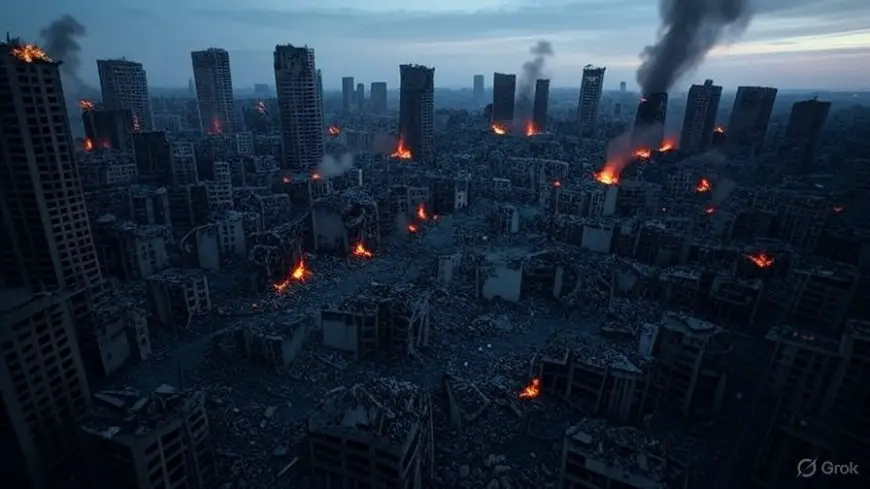World at the Brink? Analyzing 2025’s Hotspots and the Risk of World War III
This 2025 analysis assesses global conflict risks—Ukraine, Asia-Pacific, Middle East—and examines whether separate crises could spark World War III.

A World on Edge: Connecting the Flashpoints
In 2025, multiple regional conflicts—from Europe and Asia to the Middle East—are sparking fears of a broader confrontation. By tracing trends in Ukraine, the Taiwan Strait, and the Middle East, this analysis examines how isolated battles could ripple into a complex global crisis.
⚔️ Eastern Europe: Ukraine and NATO Under Stress
Russia's full-scale invasion of Ukraine continues unabated. Frontline offensives in Kherson and Donbas remain locked in bloody stalemate, but escalations persist. Moscow has flirted with nuclear rhetoric, while Kyiv is bolstered by Western arms and intelligence support crisisgroup.org+2mirasafety.com+2linkedin.com+2.
Meanwhile, NATO’s unity is strained. Internal debates around defense spending and U.S. policy uncertainty risk undermining alliance cohesion ft.com. Despite this, NATO remains an active counterweight to Russian ambitions—with troop deployments and air defense systems stationed near Ukraine's borders.
🌏 Asia-Pacific: Taiwan, South China Sea, and the “Axis of Upheaval”
Asia’s simmering tensions are equally troubling. Beijing’s military expansion near Taiwan and assertive maneuvers in the South China Sea have prompted alarm in Washington and allied capitals .
An emerging “Axis of Upheaval” (China, Russia, Iran, North Korea) is forging deeper ties through military, economic, and diplomatic cooperation www3.nnu.edu+15en.wikipedia.org+15theguardian.com+15. Experts warn this bloc may be positioning itself to seriously challenge the post–Cold War security order .
🔥 Middle East: Proxy Wars, Energy Chokes, and Nuclear Brinkmanship
In June 2025, an Israeli drone strike ignited Iran’s South Pars gas field, compressing the region’s energy infrastructure into a strategic battleground m.economictimes.com+1economictimes.indiatimes.com+1. Iran retaliated with missile and drone attacks targeting Israel, elevating concerns that proxy confrontations may mutate into direct national conflict .
Meanwhile, U.S. warships and regional coalitions have resumed operations against Houthi forces in Yemen and maintained a naval presence in the Red Sea to shield global shipping routes en.wikipedia.org+2en.wikipedia.org+219fortyfive.com+2. Heightened oil and gas prices due to energy market shockwaves—especially the Strait of Hormuz risks—underscore the global economic fallout from Middle Eastern instability theaustralian.com.au+1en.wikipedia.org+1.
🚨 The Trigger Threshold: Nuclear and Economic Dominoes
Militarized brinkmanship, nuclear threats, and global market disruptions are converging. The Doomsday Clock now sits at 89 seconds to midnight, reflecting heightened concern over nuclear war, cyberattack risks, and accelerated AI-related weapons proliferation thesun.co.uk.
Oil and gas supply concerns stemming from Red Sea and Persian Gulf flashpoints are inflating global energy prices, rattling market stability .
Strategists warn that any significant misstep—like a strike on nuclear infrastructure or an accident at sea—could ignite a broader conflict, potentially dragging multiple powers into direct hostilities.
🌍 Alliances and Deterrents: A Shifting Global Order
Western alliances face a litmus test. NATO is urging members to boost defense spending to 5% of GDP, yet internal disagreements persist ft.com. Meanwhile, U.S. focus is divided between Europe and the Indo-Pacific.
Counterbalancing this, autocratic states are tightening ties: Russia, China, Iran, and North Korea deepen military cooperation, building a network that could act as a unified front in times of crisis ft.com+1arxiv.org+1wsj.com.
Economic ties further complicate decisions: any global trade disruption stemming from military tensions would trigger severe financial and humanitarian consequences.
🔍 Probability vs. Preparedness
Can these tensions ignite a third world war by 2025? Official assessments suggest that while a full-scale global war remains unlikely in the immediate term, the risk envelope is expanding. Atlantic Council surveys and the World Economic Forum rank inter-power conflict as one of the most serious threats facing humanity in the next decade linkedin.com+1theweek.com+1.
Navigating this precarious moment demands proactive diplomacy, deterrence investments, and crisis communication. The stakes are immense—a single flashpoint could determine whether regional feuds spiral into global catastrophe.
🧭 Conclusion: What Comes Next?
-
Focus Area: Europe & Ukraine
Continued military stalemate with periodic escalations. NATO must reaffirm unity and deterrent credibility. -
Asia-Pacific Flashpoints
Monitoring of Taiwan and South China Sea is essential. Decoupling economic and military pressure is critical to avoid miscalculation. -
Middle Eastern Energy Wars
Keeping oil and gas infrastructure off the battlefield is now a global priority.
Ultimately, avoiding World War III in 2025 hinges on prevention—active diplomacy, strategic restraint, and reinforcing global institutions designed to defuse crises before they expand.














